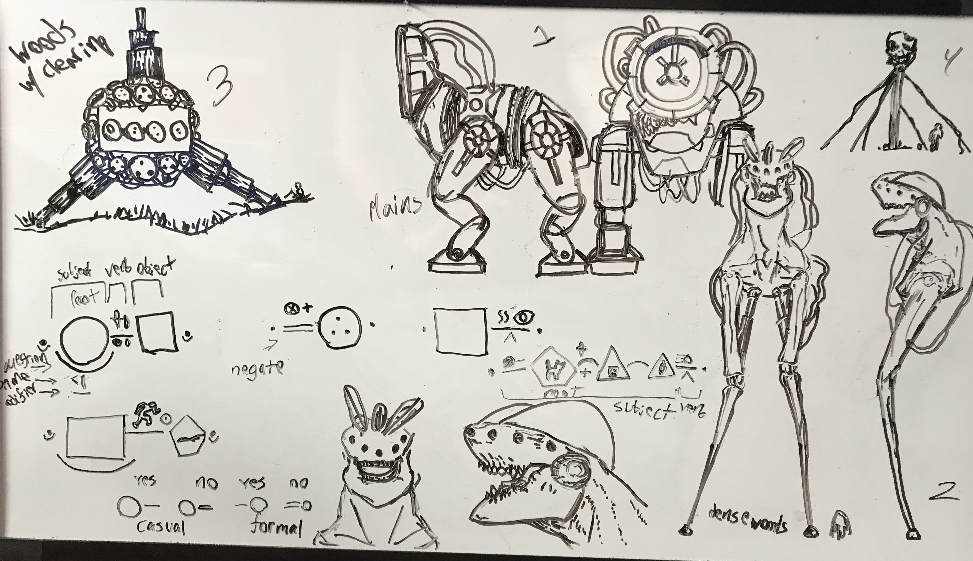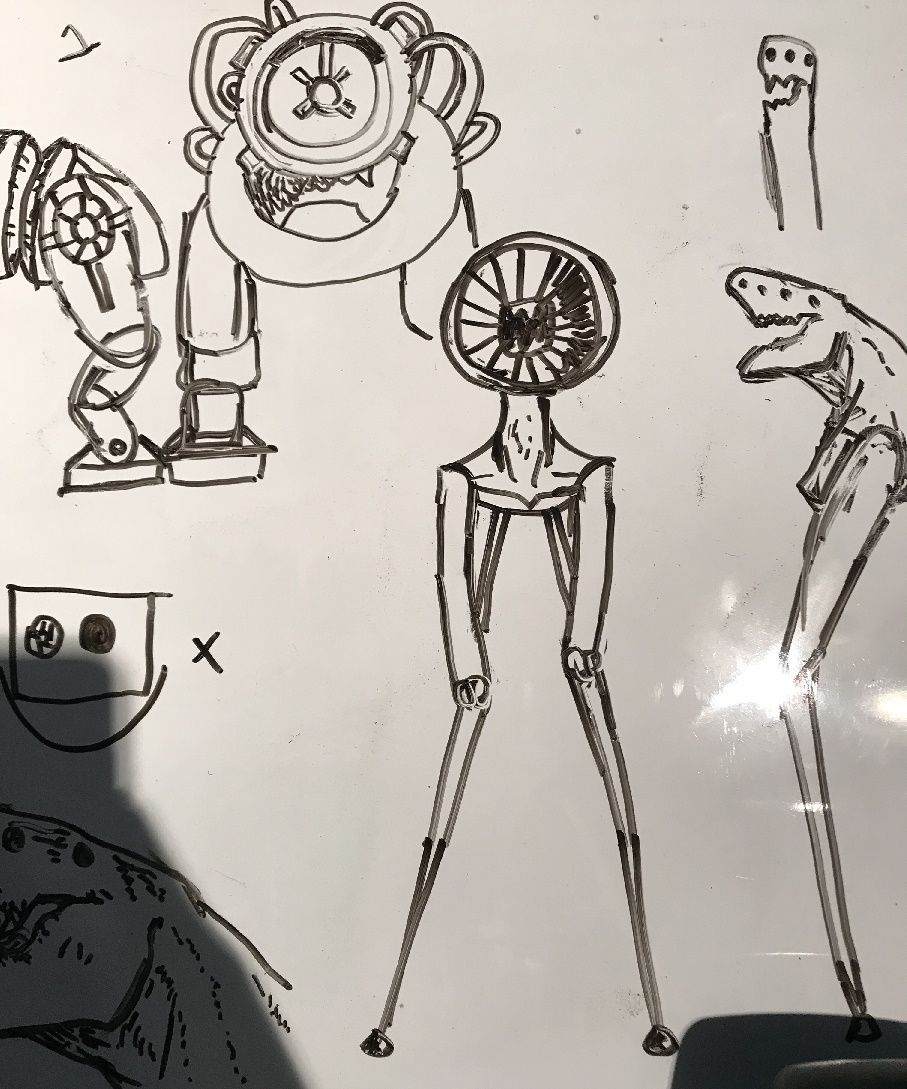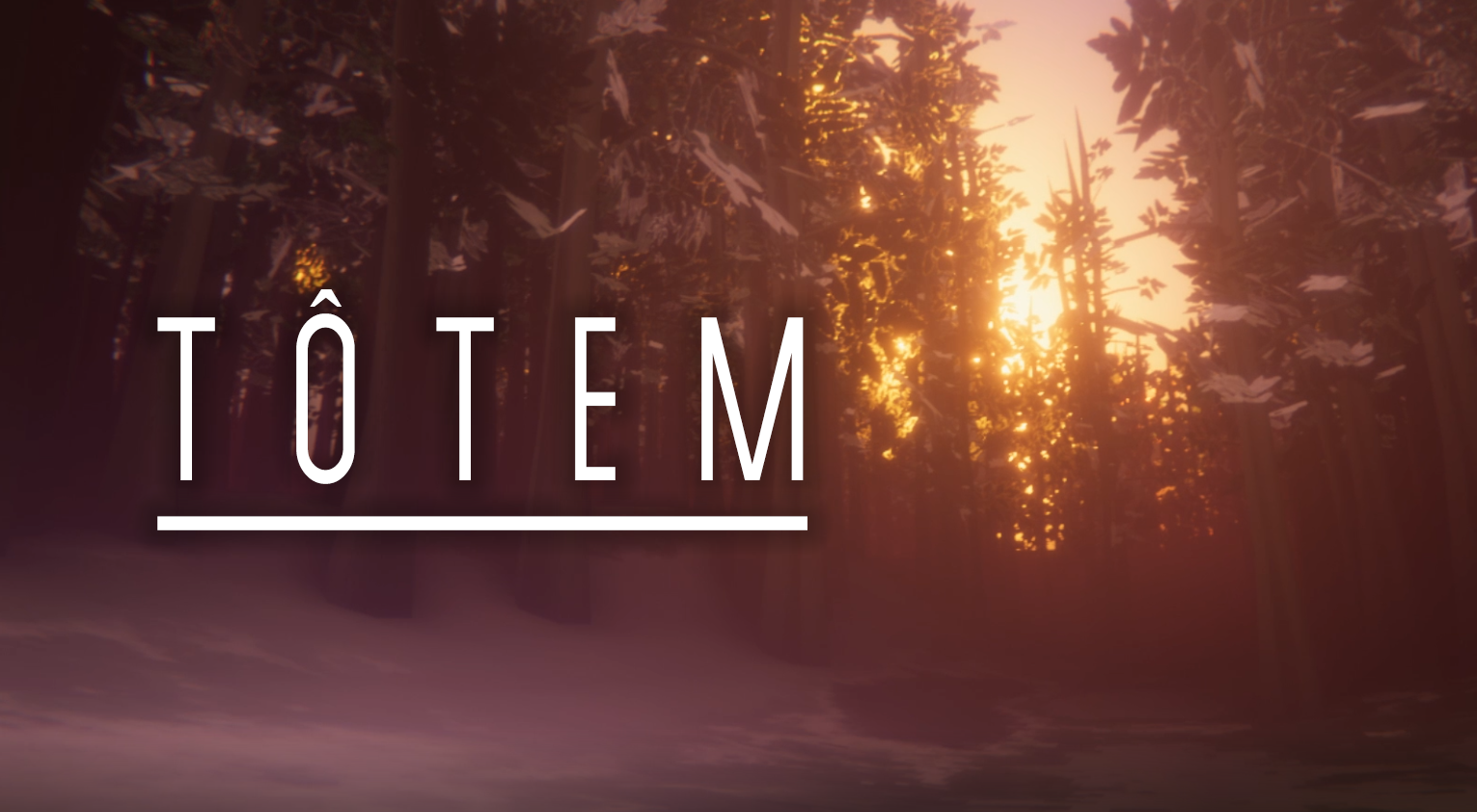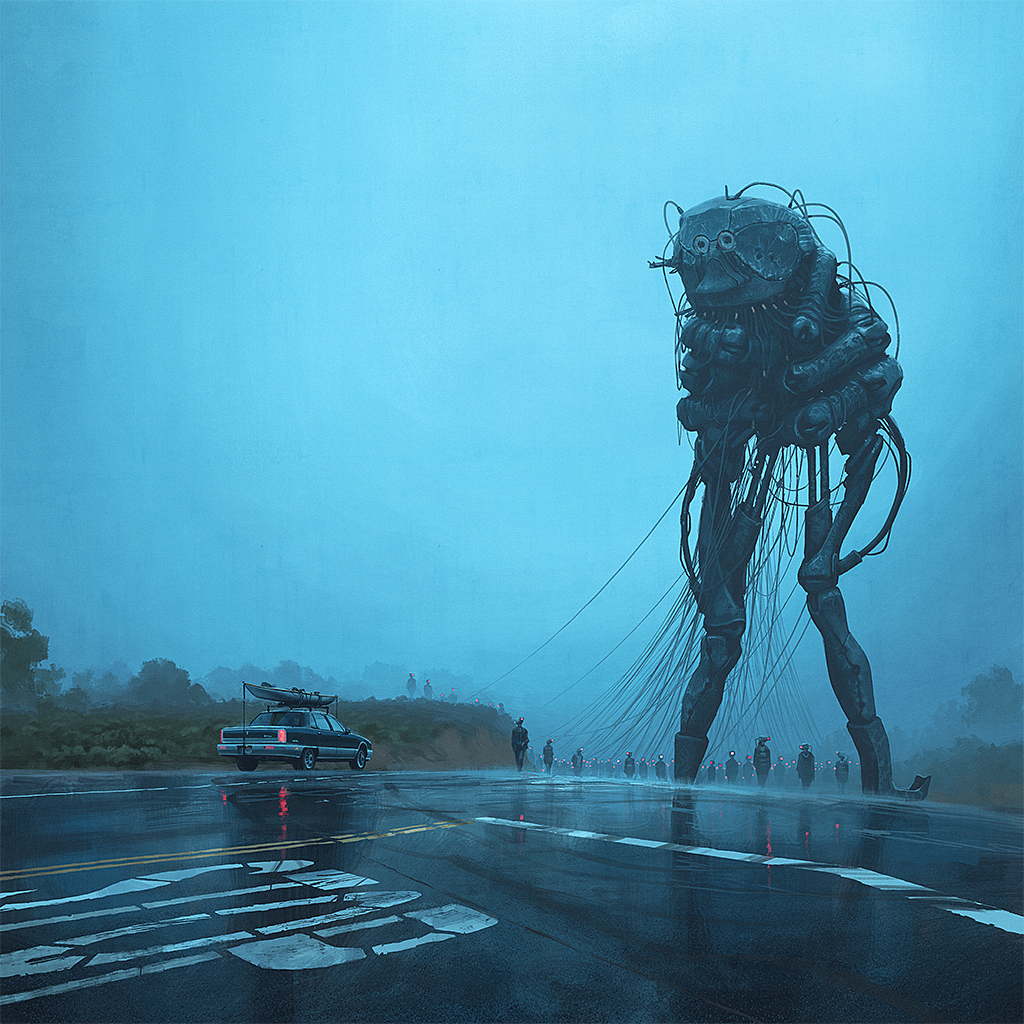The Creation of Tôtem
Hello, all!
As a little hurray for getting over 1300 downloads on Tôtem, I've decided to celebrate by making a little something special for you guys.
For those who are interested, this is going to be a rambly blog post talking about my thought process, design workflow, creature design and background, and a bunch of cut features for Tôtem.
For those who don't know, Tôtem is a unique translation game involving giant alien entities. They seem to be invading earth, so you have to convince them to stop. This isn't some easy trek either, because I purposefully made it as handhold-ey-less as possible, to force you to actually learn these alien languages.
The summary of this entire post is this: During summer of 2019, I was 2 and 1/2 months from starting my next year in university. I set for myself the goal of making a game by the time it started. Came across a painting by Simon Stålenhag, which was my main inspiration. I made some aliens, did a ton of research on all kinds of languages, designed some languages for the aliens, built the game, released it, Bob's your uncle.
Each alien will have its own "What is it?" and "Language" sections following this introduction, so feel free to skip through as you like.
INSPIRATION
In the summer of 2019, I was working on a fast-paced motorcycle game, with giant snake creatures, sunken cities, and an endless ocean. Progress was being made, but the whole foundation was shaky. I didn't really have a concrete plan, and the scope was ballooning out of proportion.
That was when I found it: a painting by Simon Stålenhag, titled "The Procession".
This was my main inspiration behind Tôtem. Just a single picture.
I imagined what I could do with a situation like that. Fight it? No, this thing is unkillable. Run from it? Maybe, but that doesn't really solve much. Well, then the answer was simple: talk to it.
But then the questions started...
What would this giant monster sound like? How does it move? Does it jump? Can it run, or just walk? Can it see, or smell? Is it sentient? Immediately, my thoughts started to focus on the aliens themselves. Clearly, the aliens were going to be the star of the show, like the painting, so how about we start with that.
Now, a language is the best way to understand someone else, so, to make it feel as alien as possible, how about the player has to communicate using their language. Better yet, to make these creatures feel as alien as possible, their languages should have no real-life counterpart.
COMING UP WITH IDEAS
I started writing stuff down, anything that could work as a means to convey information. Binary, hieroglyphs, Morse code, text, rotation, values, levels, digital displays, body language. Furthermore, how would something like text work? Would it start from the left, or the right? Top or bottom? Does it use abstract concepts, or concrete real-life references? Does it even have a concept of time? If so, does it experience it in chunks of data? In reverse? Does text work side-by-side, or one glyph inside another, like a circle in a circle? Does it even use text to talk? Does it even understand what relativism is? If it has no hands, does it understand the concept of grabbing an object? Is their language even a conscious action?
Clearly, questions are going to be endless. You could easily keep making lists and lists of what a truly alien species would, or could, know given their anatomy, and culture.
I settled on this as a concept: Three aliens, each with a different language, that both the player and the aliens would use to communicate.
Sound good?
Not for me at first. I went way further. I wanted the language to be randomly generated every time you played, I wanted the difficulty to be based on how similar the language is to the one you know. Like, for, example, the subject-verb-object order, the usage of time, the existence of word concatenation, and more.
Obviously, this can't be done in the time I had, so it was scrapped.
I also intended for the player to entirely WRITE OUT THEIR RESPONSE using the alien language instead of choosing from a set of options.
This was also quickly scrapped.
It's way too difficult to make and came with WAY too many game play issues. What if the player said something like "The trees around you are explosives and are going to blow up if you look at me". I would have to basically make the alien react accordingly, or else it would ruin the immersion and fun of the whole concept. Naturally, I wasn't going to make a full-fledged alien AI for a summer project.
The project as a whole settled on a character-centric approach because of the image, but also because I felt like this was going to be a good project for me to practice giant monster animation, since that's what my background is in. Animation in general, not just giant monster animation, though I do love it.
At first, the idea was to string all these aliens together in a story format. Each alien could be repelled, which would drive them away, or you would fail, in which case they would continue on. Each alien would have different intentions, some bad, some good, and would have different results depending on whether you stopped them or even let them through. The game would play out with a tally for how many cities have been destroyed, and you would have to manage your own food, your own money, and the world politics, kind of like in Paper, Please. You would play the role of a poor, but brilliant translator being forced into a confrontation with these things by the government. This ended up feeling very excessive, and so was changed to a more episodic format for the time I had. 3 or 4 separate aliens with no correlation to each other. Just pure gameplay.
THE ALIENS
The languages were obviously going to be quite important to the game, so I spent most of my time on them. The first language to be made was the Cow, followed by the Creaker, and then the Wreckingball.
THE COW
The Cow's language was one of the most straight forward, but challenging languages to make. The challenge didn't come from the intricacies, but from the limitations. Among the sporadic brainstorming I had when beginning the project, I had this written down for mediums of information transfer: Rotation.
WHAT IS IT? [ ENDING SPOILERS ]
The Cow is a machine purposely built by a more advanced civilization for the sole purpose of testing morals. When it came to testing planetary populations, there needed to be a way to determine how morally strong the species were. Morales for the Universe, that is. Answering in greedy, ignorant, or selfish ways are seen as a negative when it comes to the Universe's existence. Its language is a morality-centered design created by its creator and serves no other purpose other than to test morals. It has a mind of its own, but its mind is purely driven by testing and righteousness. It can be recalled at any time and can be dispatched anywhere.
THE LANGUAGE
So, Rotation. Cool, alright, I like that. Super weird, super unique, and if i'm interested, others probably are as well. Boom we got the first language style figured out.
Naturally, this language was going to be incredibly subjective. You just can't make an entire dialect work in this fashion by just cramming it with minute angles and complex rotation patterns. The player would just never understand. The language itself needed to be dumbed down so that the player can actually use it.
Because of this limitation, I based the whole character for the Cow based on that: Interpretation.
I built the framework around figuring out what the essence of its points were, and not what what said exactly. Therefore. I chose this: 8 angles, 1 word for each, speed would determine intensity, and a full circle would mean negate/invert. Naturally, there isn't much to work with, so I set about the job of figuring out what those words were. I didn't know what this character was based around at this point. All I knew was that rotation was involved.
As I was writing down words, I noticed that words naturally tended to stay around large, vague, cosmic principles, like time, space, change, intention, and morals. So you know what? Lets make this alien be all spacey and philosophical and mysterious, since that seems to jive well with every other aspect of him so far.
This guy's design was also inspired by the works of Simon Stålenhag (specifically the "Drone, Sweet Drone" one). You can see an image of his initial design in the Wreckingball section below. I naturally felt inclined to make everything giant and spooky and mysterious because I really wanted to practice my "giant-monster-and-large-powerful-movements" animation.
The gimmick of actually speaking the the alien directly did stick for this alien, in the end. I thought it would help make the aliens all feel different to play and think about, since the rest are basically "click-the-right-answer" puzzles, which definitely isn't what the game is about. It was an absolute hassle to build, but I think it made his presence feel more monumental, like a stressful, confusing "test" that was given by the ultimate English teacher. Yup, that pretty much sums up this alien. I even planned for this guy to start going on a long, philosophical speech I wrote. He was going to say it in English over a loud speaker once you beat him, just before he leaves. It's a speech about the nature of infinity, the nature of singularity, controversial morals, and the perspective of God. Ya' know, the stuff that no one wants to ever hear. So, that never made it in.
THE CREAKER
This tall boy was one of the more typical "creepy" monster designs I've made, but has the most implication culture-wise. The design is very much inspired by that first picture, with the robot cooking down at the car. Having no arms and a distorted humanoid body just looks really creepy, and I thought that would work well as you're being crushed by its sheer alien presence. The whole concept of heights also came from its statuesque size and long legs, which made it super imposing. The language itself also came from the initial brainstorm I had, in which I wrote down "volume". The language is critically different from a regular language, because it isn't meant to be written down, only expressed using a horn. It's also meant to be heard from far away, and is inherently a very rudimentary form of communication. As such, the language is less of its way of life, and more of a basic tool.
WHAT IS IT?
The Creakers exclusively use a single horn to communicate. The reason for this mode of communication comes from the alien concept itself: it's a blind pack hunter. The Creaker is entirely robotic and lives with many others of its kind, controlling vast swathes of land in a dark, deaf world. This world is entirely dark, and features barely any sound due to incredibly harsh weather, alien environments, and a thin atmosphere. The creatures there communicate through other senses, like smell and electroreception, and rarely do creatures process any kind of hearing, let alone sight.
But this creature managed to figure out a way to overpower these flaws: simply go overboard.
Their horns grew so loud and so strong so as to be heard and felt by any creature in a wide radius. The Creakers have learned to communicate using these and have become incredibly tuned to this method of communication. To disguise their immediate existence to other, more smell-focused creatures, they kill titanic flesh-based creatures and hide inside them, resulting in the distinctive shark-like exterior appearance you see in-game. Naturally, this isn't the only creature they use, so they can appear to have many forms.
THE LANGUAGE
The language and its words are really meant to be as simple as possible. "I run", "I kill", "Food is near", "We are strong", "Prey is stronger". They have no need for anything more complex because their entire "biology" is built for hunting. These are not sentient creatures who ponder the state of the universe; they simply hunt, kill, eat, and sleep. Because of this, the language is a fixed system that only has the essentials. On top of that, all of its words are species-centrered or self-centered. There is no "north" or "east", just "up" or "right", because that's all that matters when your pack is facing a nice delicious meal in the plains ahead.
The language also has some very interesting words when it comes to belief: Life, death, and God. These creatures live and breath death, but never eternally. They always move from one kill to another, and abandon their pack-members when they die. As such, the words for life and death are transient and more closely refers to the acts of "dying" and "birth". "God" is what could be described as "the one who changes" or "the enemy that we can not defeat", who is the god of everything that happens after these transient events happen; of "decomposition" and "growth".
THE WRECKINGBALL
The Cow, and Creaker's languages and designs were pretty straight forward and finished in about two weeks, but the Wreckingball's language was the most difficult one to create. It had an absolute TON of iterations which started off incredibly lofty, but eventually settled to what we see in the game now. The design for Wreckingball was very much an iterative creation. Initially, it was a big puppet head that used faces to communicate, but I eventually smoothed out the unnecessary stuff and ended up with what we have now.
WHAT IS IT?
The Wreckingball is a self-propelled database who strives to collect as much information as possible. It's fitted with two consciousnesses which is intended to capture two times the data. It does this by inspecting the same scenario from two different perspectives. The logical one searches for logical patterns that could help it physically and externally, and the emotional one searches for new cultures and emotional patterns to help it make friends to get more knowledge. It doesn't believe in a god and doesn't have any kind of superstition or culture; it's a purely useful alien made to better understand everything that could be useful. It's eventual goal is to solve every possible mystery, solve every equation, and learn about everything that could help it on its journey. It has 4 piston-like extenders that it uses to orient and propel itself around. It also has a large panel built into it which it uses to communicate. The language it uses is made to be as easy as possible to understand and interpret without much training, especially compared to many of the other alien ones.
THE LANGUAGE
My perfect idea, one that I got close to finishing, was a circle-in-circle approach, one that would represent possession by having the object's circle be enveloped by the possessor's circle, with all of their properties being glyphs displayed in their respective circle layers. The circle idea eventually turned into squares, circles, and pentagons to show whether it was a "you/your", "I/my", or "it/its". The goal was to have an entire phrase, paragraph, or book, be inside of just one symbol, by having an insanely large amount of smaller and smaller layers inside it, just like the Wreckingball's shape.
This was interesting in concept, but bad in execution: "how the heck are you going to program this, or even display it?" I told myself, and I did have a point. So I split it up and put these rings side by side, and put some extra information, like time, as glyphs underneath it

You can see one of the nearly 5 iterations of the Wreckingball language here, along with some sketched concept art. In this one, the lines with the little drawings above and below them are verbs. But these are very special. They act like verbs or descriptors depending on whether they're on the right or on the left of their subject shape. The lone right ones would be be the "emenator", essentially the verb or act that it is doing, but the lone left ones would be the "effector", essentially acting upon the subject shape with its verb, acting like an adjective. The drawings above and below the line also act as differentiators between facts and opinions, everything above is what the Wreckingball would know to be the truth, and everything below would be the opinions, the dramatizations, and the subjective stuff.
For example, the top-right one with the square would translate as this: "You are unattractive" or "You are causing an eyesore", but with subjectivity would translate as this: "You are VERY unattractive". It's subtle, but to an alien that's basically a big logical computer, straight unbiased facts matter more than anything, even when they're hurtful :( .
THE TOTEM [ ENDING SPOILERS ]
This really is the ultimate example of what the game is at its core: it's insane. At this stage, you're trying to figure out what this pole is saying, but all you hear is just seemingly random clicking, and you're forced to translate it and talk to it by sending pulses back.
It's just you, the button, and this clicking pole. Have at it.
WHAT IS IT?
Well, this big spooky telephone pole is the totem of humanity; a big representation of what humans are and do. This is Earth's neuron and it's just one of countless others found all over the universe. Just like how a brain uses many tightly packed neurons to think, the universe uses many spread-out neurons to think as well, but on a cosmic scale. The difference, however, is that each neuron is sentient and is aware of everything that is happening around it. It can report back any information it gets about the planet to the rest of the consciousness and cannot be destroyed by any means.
THE LANGUAGE
Obviously you're not meant to translate it to progress forward. You're meant to go up and touch it which reveals all of the secrets to you in a big shocking blast of information. It's the player tapping into the neuron of the universe. The language itself is untranslatable because it's encrypted within the universal consciousness. It's like trying to figure out what someone is thinking by just listening to one neuron. It basically makes no sense.
RANDOM DEVELOPMENT PICS

Initial design for Creaker, featuring a large radar dish head.

The tool I made for creating the language trees. Each box has its own set of special parameters and all responses are assembled there as well.
Anyway, that's the end of this little blog post. This was a lot of fun to write, since I always have a ton of stuff going on behind the scenes, plus a bunch of interesting backstories and details.
I'm very grateful for all the kind words and I'm glad you guys are enjoying this little experimental game! I'm not sure if i'll be posting any new games this year, but there's gonna be a really big one the year after! :)
Cheers,
Shakles
Get Tôtem
Tôtem
A Unique Translation Game With Unidentified Entities
| Status | Released |
| Author | Shakles |
| Genre | Puzzle |
| Tags | Aliens, Experimental, Forest, Horror, language, Management, Singleplayer, totem, translation |
More posts
- So, About UnitySep 15, 2023
- Gallerie Trailer Is Now Up!May 04, 2022
- Sequel Update 2Apr 30, 2022
- I'm part of THE DREAD X COLLECTION 5Feb 07, 2022
- Sequel UpdateJul 23, 2021
- Tôtem Sequel in the works!May 14, 2021
- Bug Fixes!Jun 07, 2020
- Added sensitivity slider!May 14, 2020
- Tôtem - Added Mac and Linux! + BUNDLEJan 01, 2020


Comments
Log in with itch.io to leave a comment.
Very good job with this game. Thanks for sharing this.
Thank you so much for posting this! I love knowing the inspiration behind creative efforts and this was really interesting. I am astounded that you built this in such a short time frame! It crossed my mind that it might be cool to actually have to construct sentences word for word (and not choose from a list of options) but I think the possibilities would have been too endless and perhaps the game might be unplayable.
I am curious - was the film Arrival any inspiration? I can't help but notice the similarity between the two and the same comparison was made on Waypoint Radio.
Thank you so much, man! Yeah making it so that you write every single sentence out would have been absolutely insane to build. And actually, no, I didn't have any inspiration at all from Arrival. Actually, funny thing is that up until the Arrival comparison, I always had the worst time trying to describe the game. But then, about 3/4 through making the game, I was trying to describe the game to a friend and I was struggling, but after a while, they said "Oh, so it's like Arrival". I was speechless as to how I never thought of that lol. Btw, what's Waypoint Radio?
Oh that's so interesting! I definitely would have guessed it had an influence. It does indeed make an easy way to explain the game to people.
Waypoint Radio is a podcast by Vice Games and I personally think it has some of the best commentary in the industry. It's focused on cultural criticism of games and often veers into other territories like politics. The host recently played Totem and talked about it, which is how I discovered it. You can check out that episode here https://www.vice.com/en_us/article/3azqwj/the-value-of-making-art-in-a-crisis-waypoint-radio
Ooh so that's where that uptick came from. There really isn't any way for me to know if someone talked about or shoutout the game somewhere, so I'm super stoked you brought it up! This podcast looks really interesting, i'll be sure to check it out